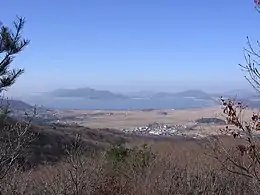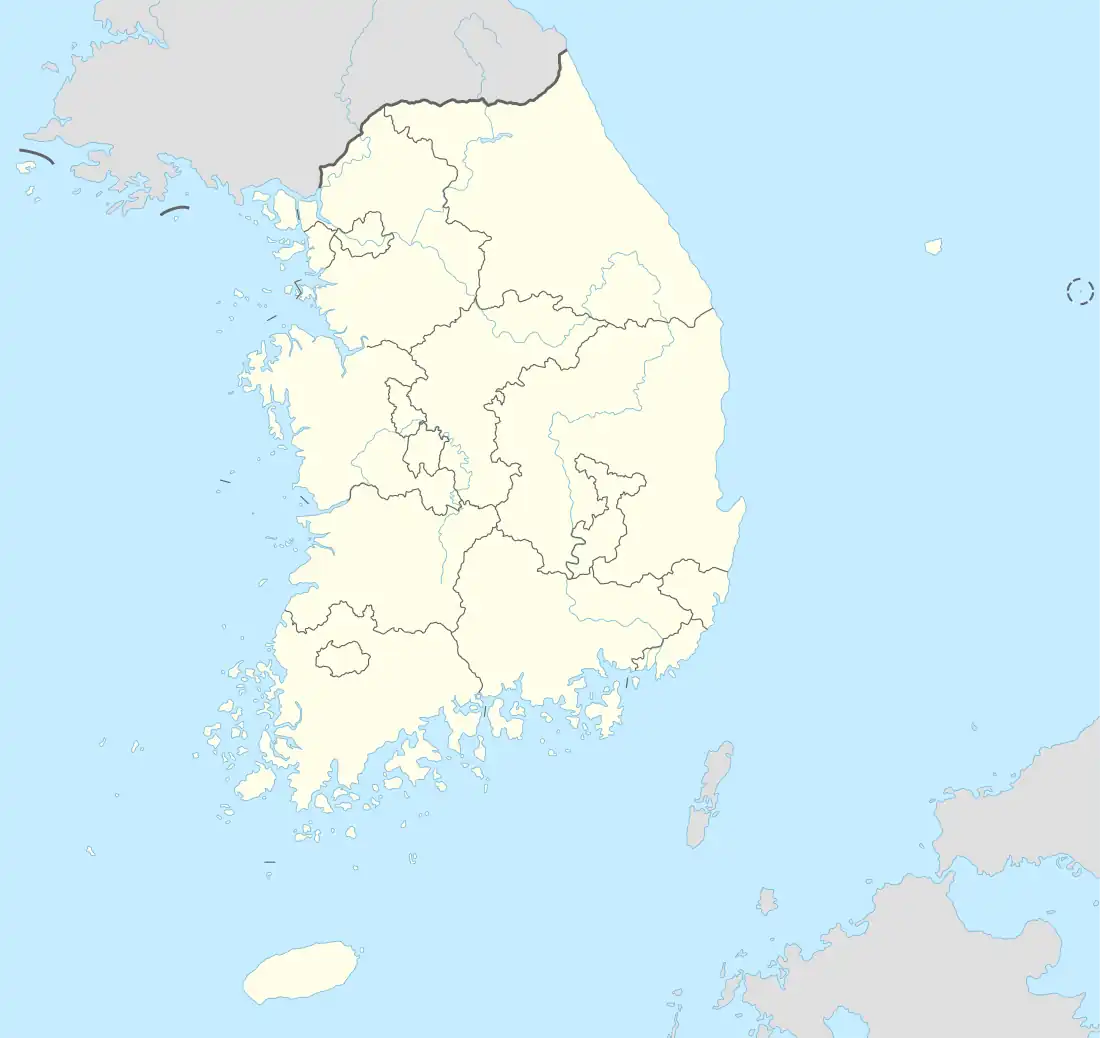 View of the island from Manisan | |
 Location of Ganghwa Island | |
 Ganghwa Island Larger map of South Korea | |
| Geography | |
|---|---|
| Location | South Korea |
| Coordinates | 37°42′N 126°26′E / 37.700°N 126.433°E |
| Area | 302.4 km2 (116.8 sq mi) |
| Demographics | |
| Population | 65,500 |
| Korean name | |
| Hangul | 강화도 |
| Hanja | 江華島 |
| Revised Romanization | Ganghwado |
| McCune–Reischauer | Kanghwado |
Ganghwa Island (Korean: 강화도), also known by its native name Ganghwado, is a South Korean island in the estuary of the Han River. It is in the Yellow Sea, off Korea's west coast. The island is separated from Gimpo (on the South Korean mainland) by a narrow channel spanned by two bridges, and from Kaesong (Gaeseong) in North Korea by the main channel of the Han River. North Korea can be seen on clear days from less than two kilometers away on South Korea's Ganghwa Island allowing better views of North Korean villages than from elsewhere in South Korea.[1]
It is strategically located, controlling access to the river which runs through former Joseon and the present South Korean capital Seoul. Its fortifications were repeatedly attacked during the 19th century. With an area of 302.4 km2 (116.8 sq mi), it constitutes most of Ganghwa County (a division of Incheon). The island has a population of about 65,500, half of whom live in Ganghwa Town (Ganghwa-eup) in the northeast.
Name
"Ganghwado" or "Ganghwa-do" (Korean: 강화도, formerly 江華島) means "island made prosperous", "illustrious" or "flourishing by the river" (in reference to its formation from the silt carried downriver by the Han River). Former romanizations include "Kang-hoa" [2] and "Kang-hwa".
Geography
The island is in the estuary of Korea's Han River. It is 302.4 km2 (116.8 sq mi), 28 kilometers (17 mi) long and 22 kilometers (14 mi) wide, the fourth-largest island in South Korea. The island's highest point is Mani-san (469 m or 1,539 ft above sea level).
Climate
| Climate data for Ganghwa (1991–2020 normals, extremes 1972–present) | |||||||||||||
|---|---|---|---|---|---|---|---|---|---|---|---|---|---|
| Month | Jan | Feb | Mar | Apr | May | Jun | Jul | Aug | Sep | Oct | Nov | Dec | Year |
| Record high °C (°F) | 12.6 (54.7) |
17.4 (63.3) |
22.3 (72.1) |
29.2 (84.6) |
31.0 (87.8) |
33.2 (91.8) |
35.5 (95.9) |
35.8 (96.4) |
31.7 (89.1) |
28.3 (82.9) |
23.8 (74.8) |
16.0 (60.8) |
35.8 (96.4) |
| Mean daily maximum °C (°F) | 1.7 (35.1) |
4.5 (40.1) |
9.8 (49.6) |
16.2 (61.2) |
21.4 (70.5) |
25.4 (77.7) |
27.6 (81.7) |
29.0 (84.2) |
25.5 (77.9) |
19.5 (67.1) |
11.5 (52.7) |
3.9 (39.0) |
16.3 (61.3) |
| Daily mean °C (°F) | −3.2 (26.2) |
−0.7 (30.7) |
4.6 (40.3) |
10.7 (51.3) |
16.0 (60.8) |
20.5 (68.9) |
23.7 (74.7) |
24.7 (76.5) |
20.2 (68.4) |
13.7 (56.7) |
6.3 (43.3) |
−0.9 (30.4) |
11.3 (52.3) |
| Mean daily minimum °C (°F) | −8.1 (17.4) |
−5.8 (21.6) |
−0.6 (30.9) |
5.3 (41.5) |
11.0 (51.8) |
16.3 (61.3) |
20.6 (69.1) |
21.2 (70.2) |
15.6 (60.1) |
8.1 (46.6) |
1.2 (34.2) |
−5.7 (21.7) |
6.6 (43.9) |
| Record low °C (°F) | −22.5 (−8.5) |
−19.4 (−2.9) |
−11.3 (11.7) |
−4.4 (24.1) |
1.6 (34.9) |
6.9 (44.4) |
12.7 (54.9) |
12.5 (54.5) |
3.0 (37.4) |
−4.2 (24.4) |
−12.0 (10.4) |
−19.8 (−3.6) |
−22.5 (−8.5) |
| Average precipitation mm (inches) | 15.6 (0.61) |
22.5 (0.89) |
31.4 (1.24) |
64.9 (2.56) |
110.9 (4.37) |
110.0 (4.33) |
355.6 (14.00) |
300.4 (11.83) |
131.5 (5.18) |
55.8 (2.20) |
46.3 (1.82) |
21.3 (0.84) |
1,266.2 (49.85) |
| Average precipitation days (≥ 0.1 mm) | 5.0 | 4.8 | 6.0 | 7.5 | 8.2 | 8.6 | 14.1 | 11.9 | 7.4 | 5.6 | 7.5 | 6.6 | 93.2 |
| Average snowy days | 7.3 | 4.3 | 2.4 | 0.2 | 0.0 | 0.0 | 0.0 | 0.0 | 0.0 | 0.1 | 1.5 | 5.1 | 20.6 |
| Average relative humidity (%) | 63.6 | 61.0 | 61.4 | 62.4 | 68.6 | 75.1 | 82.8 | 79.9 | 73.8 | 68.9 | 67.8 | 65.4 | 69.2 |
| Mean monthly sunshine hours | 186.2 | 186.5 | 217.0 | 221.7 | 235.3 | 208.5 | 153.0 | 184.9 | 203.8 | 214.3 | 166.0 | 171.8 | 2,349 |
| Percent possible sunshine | 58.7 | 61.8 | 58.9 | 59.0 | 54.8 | 50.0 | 38.6 | 47.7 | 57.4 | 63.3 | 55.7 | 55.6 | 54.6 |
| Source: Korea Meteorological Administration (percent sunshine 1981–2010)[3][4][5] | |||||||||||||
History
With the primary fortifications protecting the Joseon capital of Seoul from foreign invasion, Ganghwa Island was the site of several 19th-century punitive expeditions. The mass execution of Catholic French missionaries and Korean converts under the ministry of the Heungseon Daewongun in the mid-1860s led to a French invasion in 1866 which held the island for several weeks, although the inability of Admiral Pierre-Gustave Roze to sail up the shallow, uncharted Han River and attack its fortified monasteries prevented overland incursion. In 1871, a Korean assault on an American diplomatic mission led to the Battle of Ganghwa. Rear Admiral Rodgers took five forts on the island, but withdrew after the Koreans refused to negotiate. After an 1868 diplomatic incident related to Korea's refusal to recognize the imperial status of the emperor of Japan, the forts at Ganghwa fired on a Japanese boat from the surveying gunship Un'yō in 1875. During the Japanese Battle of Ganghwa, Un'yō captain Inoue Yoshika silenced the batteries with superior firepower and landed a raiding force which plundered local communities. The Imperial Japanese Navy blockaded the area and compelled the 1876 Treaty of Ganghwa, which opened Korea to Japanese commerce.
1871 invasion by U.S. warships
In 1866, the General Sherman arrived at Pyongyang via the Daedong River. A Welsh pastor, Thomas, was a crewman traveling for missionary work to Joseon. Pyongyang governor Park Gyu-su, Park Ji-won's grandson, informed the crew about his refusal to allow trade and advised them to go back. Disputes worsened among the crew; after they kidnapped a Joseon official and held him hostage, Korean authorities sank the boat and killed the surviving crew.
In 1871, during the Joseon expedition, the U.S. decided to open a port. It ordered the Joseon expedition to Asia, led by Fleet Commander Rogers. On June 1, The U.S. led sounding navigation of the Ganghwa Strait. When the fleet arrived in Sondolmok, it was attacked from the coastline by a Ganghwa artillery unit.
The American fleet seized the Chojijin Fort with naval gunfire. The American army took over Deokjjinjin Fort on June 11, and began the Gwangseongbo operation. After an hour of land and sea shelling, the American army captured Gwangseongbo. Three Americans were killed, and 10 wounded. Three hundred fifty Koreans were killed, and 20 wounded.
Therapeutic turnip
The island's turnip (Brassica rapa) has been cultivated for over a thousand years. Its moisture content is over 90 percent, and its main component is carbohydrate. The dark-purple, taproot vegetable has a mustardy scent and tastes like ginseng. The turnip's seeds and fully-grown vegetable are used in folk remedies and Oriental medicine. Its leaves have vitamins, and its roots contain tryptophan and glycyrrhizin. Said to have anticancer activity, the turnip helps cure skin diseases, digestive ailments, tuberculosis and respiratory disease with an anti-bacterial effect.[6][7]
Festivals
- Goryeo Azalea Festival: Mid-April at Dolmen Square on Goryeo Mountain
- Ganghwa Salted Shrimp Festival: Early October at Oepo-ri dock
- Ganghwa Foundation Day Grand Festival: October 1–3 in Chamseongdan on Manisan
Tourist attractions
- Ganghwa Nadeulgil
- A 20-trail walking tour, illustrating history from prehistory to the Joseon dynasty the mudflat ecology and avian migratory habitats
- Seongmodo
- A level 10-mile (16 km) trail through a forest and the island's only beach, ending at a temple[8]
- Pungmul Market
- A food market selling grain, vegetables, fruits, seafood, meat, fish, tofu and ginseng
- Goryeogung Palace
- Palace site of Goryeo from 1232 to 1270 in Incheon. Popular with hikers and for its cherry blossoms in spring
- Manisan
- Ganghwa's highest mountain and home of Chamseongdan Altar, where Dangun Wanggeom reportedly performed ancestral rites[9]
Notable people
See also
References
Citations
- ↑ Pants and propaganda: Photos from Korean border area show life in North Korea
- ↑ EB (1878), p. 393.
- ↑ "Climatological Normals of Korea (1991 ~ 2020)" (PDF) (in Korean). Korea Meteorological Administration. Archived from the original (PDF) on 29 January 2022. Retrieved 4 April 2022.
- ↑ 순위값 - 구역별조회 (in Korean). Korea Meteorological Administration. Retrieved 4 April 2022.
- ↑ "Climatological Normals of Korea" (PDF). Korea Meteorological Administration. 2011. Archived from the original (PDF) on 7 December 2016. Retrieved 8 December 2016.
- ↑ "강화도 순무". 인천광역시. Archived from the original on 1 August 2017. Retrieved 1 August 2017.
- ↑ "순무". 농식품백과사전. Retrieved 1 August 2017.
- ↑ "Hidden trails that highlight Korean beauty". Korea JoongAng Daily. Retrieved 2018-05-25.
- ↑ "Destinations by Region : VisitKorea Destinations by Region Chamseongdan Altar (강화 참성단) | Official Korea Tourism Organization".
- ↑ Browning, Kellen (30 January 2021). "They're Flocking to America to Make a Fortune Playing Video Games". The New York Times.
Bibliography
- , 'Encyclopædia Britannica, 9th ed., Vol. VI, New York: Charles Scribner's Sons, 1878, pp. 390–394.